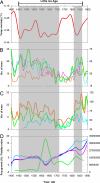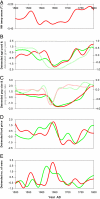Global climate change, war, and population decline in recent human history
- PMID: 18048343
- PMCID: PMC2148270
- DOI: 10.1073/pnas.0703073104
Global climate change, war, and population decline in recent human history
Abstract
Although scientists have warned of possible social perils resulting from climate change, the impacts of long-term climate change on social unrest and population collapse have not been quantitatively investigated. In this study, high-resolution paleo-climatic data have been used to explore at a macroscale the effects of climate change on the outbreak of war and population decline in the preindustrial era. We show that long-term fluctuations of war frequency and population changes followed the cycles of temperature change. Further analyses show that cooling impeded agricultural production, which brought about a series of serious social problems, including price inflation, then successively war outbreak, famine, and population decline successively. The findings suggest that worldwide and synchronistic war-peace, population, and price cycles in recent centuries have been driven mainly by long-term climate change. The findings also imply that social mechanisms that might mitigate the impact of climate change were not significantly effective during the study period. Climate change may thus have played a more important role and imposed a wider ranging effect on human civilization than has so far been suggested. Findings of this research may lend an additional dimension to the classic concepts of Malthusianism and Darwinism.
Conflict of interest statement
The authors declare no conflict of interest.
Figures


References
-
- National Research Council. Decade-to-Century-Scale Climate Variability and Change: A Science Strategy. Washington, DC: Natl Acad Press; 1998.
-
- Polyak VJ, Asmerom Y. Science. 2001;294:148–151. - PubMed
-
- Weiss H, Bradley RS. Science. 2001;291:609–610. - PubMed
-
- Wu W, Liu T. Q Sci. 2001;21:443–451.
-
- Webster D. Am Antiquity. 1975;40:464–470.
Publication types
MeSH terms
LinkOut - more resources
Full Text Sources
Other Literature Sources

